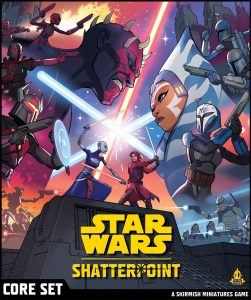 Fans of Star Wars have been playing fighting with the characters of the series since the early 80s. Every child who had the Star Wars action figures would reenact battle with Luke, Obi Wan, Darth Vader, and others on their beds, carpets, or dining room tables. I remember when the prequels were released in the late 90s when I was in college. We made a special trip to Meijer just to buy a ton of Star Wars toys for the new movies. Did I need them? No. Did I buy way too many? You know it.
Fans of Star Wars have been playing fighting with the characters of the series since the early 80s. Every child who had the Star Wars action figures would reenact battle with Luke, Obi Wan, Darth Vader, and others on their beds, carpets, or dining room tables. I remember when the prequels were released in the late 90s when I was in college. We made a special trip to Meijer just to buy a ton of Star Wars toys for the new movies. Did I need them? No. Did I buy way too many? You know it.
Up until now, the biggest Star Wars skirmish game out there (on land at least) was Star Wars: Legion. It’s a great game in its own right but is more about control squads of unnamed units (stormtroopers, rebel saboteurs) with the occasional named leader unit. But 2023 flipped that on its head as Atomic Mass Games brought us Star Wars: Shatterpoint. It’s a duel among iconic Star Wars heroes and villains for control points on the map. Is this the game that fans have been waiting for? Let’s find out!
Gameplay Overview:
As you might expect, Star Wars: Shatterpoint has a lot going on, so I’m just going to give you a high-level overview of the gameplay. If you want the full rules, you can download a PDF of the rulebook here.
To start the game, players must first assemble a strike team of two squads. Each squad has a Primary character, a secondary unit, and a supporting unit. The primary gets points to spend on secondary and supporting units. But for the most part, you’ll have 1 primary, 1 secondary, and 1 supporting unit (made of 1-2 characters). Do that twice and you are good to go.
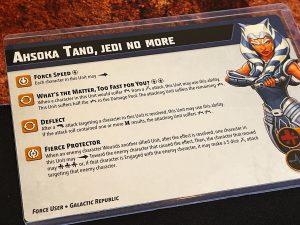
On your turn, you’ll draw the top card for your order deck to see what unit gets to activate. You can take two actions with that unit (no repeats).
- Move: Use the movement tool to move your character around the battlefield. There is no grid here as everything is done with range tools. You’ll do either a short or long move (called Dash or Advance) depending on if enemies are around you. You can also climb terrain to a higher elevation.
- Recover: Heal a damage or remove a condition
- Take Cover: Hunker down to help your defense
- Focus: Gain +1 die on your next attack roll this round
- Combat: Each character in the unit may attack.
To attack, you roll dice equal to your combat value, and the defender rolls dice equal to their defense value. For each hit the attacker scores in excess of the defender’s blocks, they gain one step on their “stance” track. These will cause damage, move enemies around the battlefield, inflict conditions, or maybe even heal themselves.
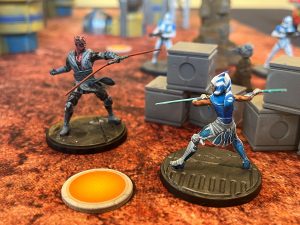
When a character takes damage equal to their health, they are wounded and out of the game until their next turn when they recover and gain an injury token. They are then back in the fight. If they gain injury tokens equal to their max, they are out of the fight.
Players also have a host of special abilities, many of which require an action to use, and/or spending Force points. Those are a limited pool of tokens that only refresh after you’ve fully cycled your initiative deck.
Finally, at the end of a turn, you’ll advance the struggle marker a number of spaces towards your side equal to how many objectives you control. If the marker ever reaches one of your momentum markers, you win the struggle. The first to win 2 out of 3 struggles wins the game.
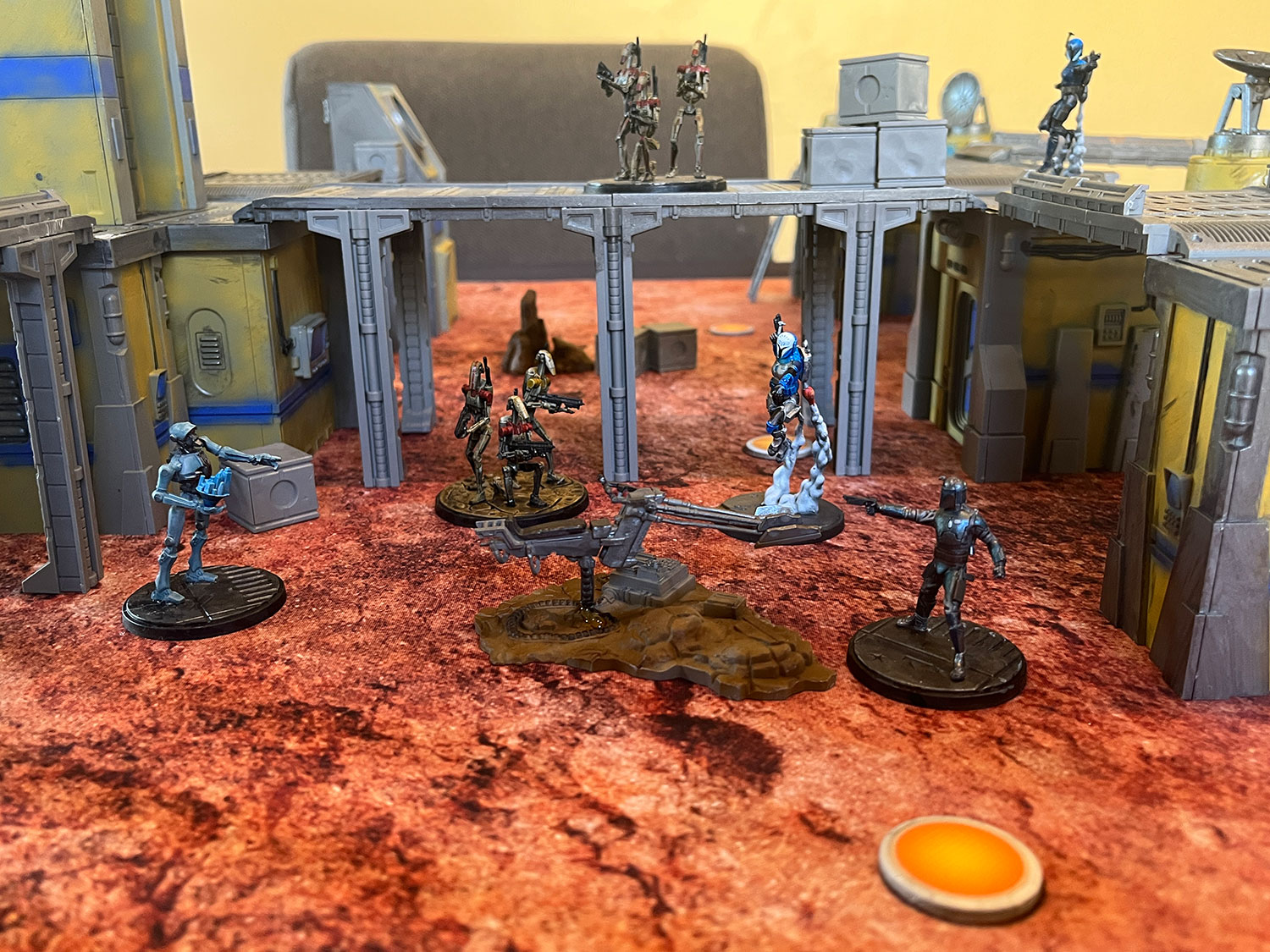
Game Experience:
So first things first. Star Wars Shatterpoint isn’t really an entry-level skirmish game that you will jump in and start playing in a few minutes. Something like Star Wars: X-Wing, Unmatched, or Battletech where you can just open the box, read a handful of rules, and get playing is better for players new to the genre. Shatterpoint first requires you to assemble the miniatures (with clippers and glue), optionally paint them, and then assemble the terrain in the same way. While the minis are not hard to put together (other than those darn battle droids), they do take a good amount of time and some are quite fragile (I’m looking at you lightsabers). You’ll need to take your time and be careful.
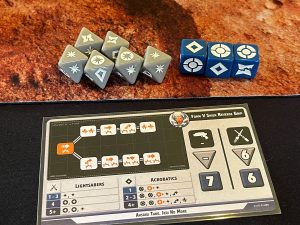
And then there are the rules. The rulebook is… not great (if I’m being generous). Stuff is all over the place, and it’s not very easy to learn the game from. I ended up watching a video online to get a feel for the gameplay and used a mobile website as a rules reference. Then, each character has a lot of abilities, some of which are walls of text and will interact with other characters in your squad. You’ll have six cards and learning them all will take a bit of time.
So, if you haven’t run away screaming yet, then you are probably wondering if the gameplay is worth the learning curve. And for that, I can solidly answer that yes it is. Star Wars: Statterpoint has a cinematic feel of the classic battles from the movies and shows. You’ll be jumping around the battlefield, striking your enemies, and bragging about how you have the high ground. This isn’t a game like Star Wars: legion where you have a mass of units in cover shooting across the battlefield to whittle your opponent’s units down.
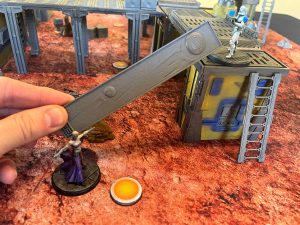
Combat is in your face, with lots of characters using melee attacks. The reason for this is that your main goal is to control objective points, not take out your enemies (although that helps). Controlling objectives gives you struggle points, which is how you win. Sure, wounding an enemy gives you momentum which helps, but it’s not the primary goal. Is that good? You can really look at it two ways.
One, it can be satisfying to see your opponent’s units fall to your brilliant tactics and lucky dice rolls. On the other side, it’s not very fun to have those units you spent 3-4 hours assembling and painting die in the first 2 minutes of the battle. Star Wars: Shatterpoint lets you use your characters throughout most of the gameplay. When you have strategies that center around powers and unit interaction it’s nice to not have one of your anchor characters faceplant in the first round.
That also means that player skill is going to be an important factor. Once you get outside of the core box, there are tons of characters you can buy in squad packs. This means that how you assemble your strike team will be important, as well as how you use your characters. Those massive walls of abilities? They are going to interact with other players and your own teammates in various ways, and once you learn them, you can do a lot of cool things. But it takes time to wrap your head around everything that can or can’t be done.
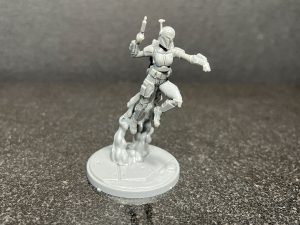
Speaking of Strike teams, I do want to give props to Atomic Mass Games for including two full strike teams in the core box, along with a nice set of terrain to use. Too many times I’ve seen skirmish games include only partial teams to give you a small taste of the game and then require you to buy add-on packs to get the full experience. Not so here, you get the full game right in the core box. While it’s not cheap, I at least feel like I have a complete experience.
Finally, I want to talk about the missions. Each game of Shatterpoint uses a mission to set up the battlefield and throw out new rules for a struggle. The core game comes with one mission, and for the most part, it’s kind of bland. It works and makes it easier to learn the game, but it’s not exactly exciting. The objective points are pretty static and symmetrical. I’d recommend it for your first game for sure, but after that, you might want to try out one of the mission packs.
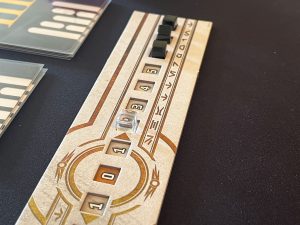
For this review, Atomic Mass also sent over their “Never Tell Me the Odds” mission pack. This one is quite different from the core game, with more objective points, all of which are not evenly spaced on a grid like the core one. What changes up here is that the struggle cards determine which unit type is “challenging the odds”. What does that mean? When a unit that’s challenging the odds wounds another unit, you can get a struggle point if you pay a force.
Normally wounding a unit only gives you momentum. Now you gain momentum AND a struggle point. This makes combat a lot more focused as taking out your enemies can yield strong benefits. Combine that with the fact that the objective points are more numerous and a lot closer together and you have a bloodbath in the making. I really liked the mission pack and I’ll probably use it way more than the core one. The downside? Missions packs cost about $15 and that’s just for 10 cards and a few punchboard tokens. Feels super-priced compared to what’s in the box.
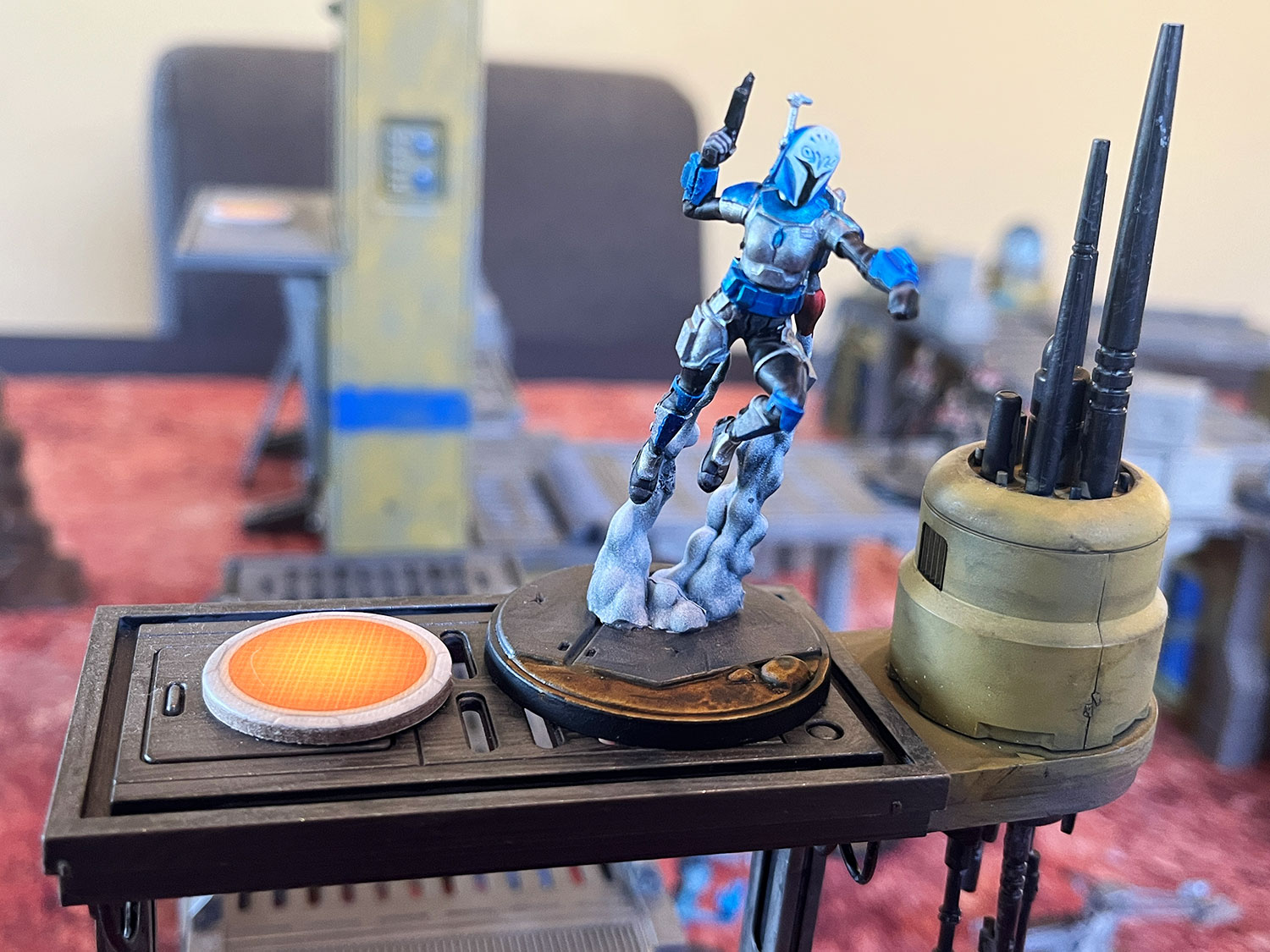
Final Thoughts:
Star Wars: Shatterpoint is definitely a unique skirmish game, yet one that fully embraces the IP it’s based on. Much like iconic characters in the movies and shows have solid “plot armor”, the same applies here. While you may wound Asoka or Ventriss, they will be popping back up in a few minutes ready to continue the fight. And when you finally are able to cut Darth Maul in half, it will be at the very end of a tough battle.
If you are looking for a game where you command massive armies and your enemies are destroyed left and right, then you are probably better off with Star Wars: Legion. It’s not uncommon for only 1-2 characters to be taken out of the game in Shatteproint. But what you do get is a cinematic battle of iconic Star Wars characters flying around the battlefield, swinging lightsabers, shooting blasters, and using really cool force powers to control key points on the battlefield. I was debating on whether I wanted to keep both Star Wars Legion and Shatterpoint on my shelf, and I think they are different enough that I can happily own both.
Final Score: 4 Stars – A unique skirmish game that lets you control iconic Star Wars Characters. Once you get past the setup and learning, its a blast to play.
 Hits:
Hits:
• Unique ruleset
• Best 2 out of three struggles keep things interesting
• Full experience in the core box
• Great looking minis
• Many, many options for squad building with expansions
Misses:
• Rulebook is pretty bad
• Some of the minis are a bit fragile
• Mission packs are pretty expensive for what you get





















